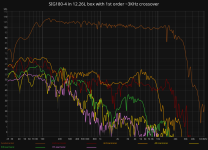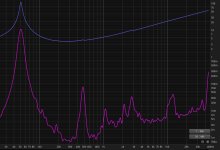Hello , cheer up Dayton Audio for this DIY gem :
https://cdn.xingosoftware.com/audioxpress/images/fetch/dpr_2.25,w_300,h_394,c_fit/https://audioxpress.com/assets/upload/images/1/20240228205005_20240228180745-VC-Cover202403--March1.jpg
Measurements by Vance Dickason are way better than expected , the Sig180-4 show no weaknesses!
Am I dreaming ... or some good soul alien must have beamed me into wonderland 🙂
But wait until the Sig120-4 will be klippelized , I guess some other designers will burst into tears seeing the meas' results!
Future is golden! (in our little DIY universe)
https://cdn.xingosoftware.com/audioxpress/images/fetch/dpr_2.25,w_300,h_394,c_fit/https://audioxpress.com/assets/upload/images/1/20240228205005_20240228180745-VC-Cover202403--March1.jpg
Measurements by Vance Dickason are way better than expected , the Sig180-4 show no weaknesses!
Am I dreaming ... or some good soul alien must have beamed me into wonderland 🙂
But wait until the Sig120-4 will be klippelized , I guess some other designers will burst into tears seeing the meas' results!
Future is golden! (in our little DIY universe)
Last edited:
https://www.diy-hifi-forum.eu/forum/attachment.php?attachmentid=73639&d=1710243428
Picture of a new SB Textreme driver presented of their Instagram page ...
How cruel to torture us with prices that only a few builders can afford!
Dayton for rescue please 🙂
Picture of a new SB Textreme driver presented of their Instagram page ...
How cruel to torture us with prices that only a few builders can afford!
Dayton for rescue please 🙂
Btw - AudioXpress March 2024 can be downloaded using an rutracker.org account! Very friendly by the russians(?) to serve us with some tasty fruits (yam-yam) ... (lol)
https://rutracker.org/forum/tracker.php?nm=voice coil
https://rutracker.org/forum/tracker.php?nm=voice coil
Sorry you make a wrong conclusion here , "exellent mechanical damping" is meant to have an influence on the SMOOTH frequency response! (it is in fact exceptional smooth)
Since the coil carrier allows no eddy currents in the 1-turn foil winding it's effect on the LF damping is close to null!
praise the speakerlord above to have mercy on us techsinners 🙂
Since the coil carrier allows no eddy currents in the 1-turn foil winding it's effect on the LF damping is close to null!
praise the speakerlord above to have mercy on us techsinners 🙂
This is at 94dB, don't get all the fuss to be perfectly honest?
Looks like a pretty standard speaker to me.
H3 is a bit to high at the wrong places.
Measurements line up with the measurements from https://hifi-selbstbau.de/

BL is nice an linear (won't show here), but Kms is a total mess;

Although a bit deceiving because it's really zoomed in.
(75% of Cms value is well outside this graph)
The DSA175 cost almost the same amount of money, but has a nicer performance if it comes down to pure midrange I think.
https://audioxpress.com/article/test-bench-dayton-audio-dsa175-designer-series-6-5-woofer
However, the cone excursion is really limited;
Unfortunate choice why they went for 4 ohm with this SIG180.
I think it would be a very nice speaker in a 3-way system.
Looks like a pretty standard speaker to me.
H3 is a bit to high at the wrong places.
Measurements line up with the measurements from https://hifi-selbstbau.de/
BL is nice an linear (won't show here), but Kms is a total mess;
Although a bit deceiving because it's really zoomed in.
(75% of Cms value is well outside this graph)
Displacement limiting numbers calculated by the Klippel
analyzer for the Dayton Audio SIG180-4 was XBl @ 82%
Bl=5.2mm and for XC @ 75%, Cms minimum was 7.4mm,
which means that for the SIG180-4, the Bl was the most
limiting factor at the prescribed distortion level of 10%,
however both numbers exceeded the physical Xmax number.
The DSA175 cost almost the same amount of money, but has a nicer performance if it comes down to pure midrange I think.
https://audioxpress.com/article/test-bench-dayton-audio-dsa175-designer-series-6-5-woofer
However, the cone excursion is really limited;
The DSA175’s displacement limiting numbers were XBl at 82% Bl = 4.6 mm and for crossover (XC) at 75% Cms minimum was 2.1 mm, which means that for this Dayton home audio driver, the compliance is the most limiting factor for prescribed distortion level of 10%.
Unfortunate choice why they went for 4 ohm with this SIG180.
I think it would be a very nice speaker in a 3-way system.
Last edited:
I was able to experiment with a SIG180-4 in a 12.26L box.
The distortion measurement above doesn't really look right based on my experience.
Some quirks of this driver:
At 1.2KHz there is a peak due to an abrupt change in directivity, so in a bookshelf speaker you would want to be listening below the axis of the woofer since it gets worse when you listen in front of the tweeter.
Around 500Hz there is a wolf note that is very audble but hard to find in the measurements. It corresponds to peaks in both the 5th and 7th harmonic and a minimum of the 3rd harmonic.
The 3rd harmonic peaks around 3KHz, but this is not a localized phenomenon, it is just the motor's 3rd harmonic coming out through the acoustic response. In any sane crossover the 3rd harmonic will not peak so much.
In terms of the sound I can get it to sound pretty good, but not so much so that I don't feel drawn toward my SDS160 or other few woofers I have to see if they might sound better.
Plain distortion chart:

Same chart but with the harmonics plotted at their natural frequencies. Notice the 7th harmonic peak at 600Hz:

Same data, but this time plotted with the harmonics normalized to SPL at the harmonic frequency. The lines become straight, showing that the distortions present here are mainly consequences of normal motor and suspension behavior:

Distortion with a notch filter and 1st order crossover:

The distortion measurement above doesn't really look right based on my experience.
Some quirks of this driver:
At 1.2KHz there is a peak due to an abrupt change in directivity, so in a bookshelf speaker you would want to be listening below the axis of the woofer since it gets worse when you listen in front of the tweeter.
Around 500Hz there is a wolf note that is very audble but hard to find in the measurements. It corresponds to peaks in both the 5th and 7th harmonic and a minimum of the 3rd harmonic.
The 3rd harmonic peaks around 3KHz, but this is not a localized phenomenon, it is just the motor's 3rd harmonic coming out through the acoustic response. In any sane crossover the 3rd harmonic will not peak so much.
In terms of the sound I can get it to sound pretty good, but not so much so that I don't feel drawn toward my SDS160 or other few woofers I have to see if they might sound better.
Plain distortion chart:
Same chart but with the harmonics plotted at their natural frequencies. Notice the 7th harmonic peak at 600Hz:
Same data, but this time plotted with the harmonics normalized to SPL at the harmonic frequency. The lines become straight, showing that the distortions present here are mainly consequences of normal motor and suspension behavior:
Distortion with a notch filter and 1st order crossover:
Attachments
This is really nice descriptive info to accompany the objective measurements which look fine and wouldn't necessarily reveal this....
Some quirks of this driver:
...
Around 500Hz there is a wolf note that is very audible but hard to find in the measurements. It corresponds to peaks in both the 5th and 7th harmonic and a minimum of the 3rd harmonic.
I find the bold comment particularly interesting, as there is a quite recent thread at ASR with almost everyone agreeing with the conventional wisdom that if it measures good it must sound relatively good. I'm of the opinion that measurements are nice, but our ears are more important.
Well you don't know what the measurements mean until you have identified what you hear in the measurements. Yes, there is bias and confounders and a lot of things that cause mistakes, but regardless the point is to figure out how something we hear shows up in the measurements. Just because it is hard does not mean it is not the goal. I watch the spectrum while I am listening to music, that way when I hear something wrong I know exactly what frequencies were being played.
On the other hand sometimes something sounds perfectly fine while listening even though there is something in the measurements that seems like it should be audible.
In this case if I set the measurement window more carefully the problems show up more clearly.

I don't know if the 580Hz resonance is related to the 480Hz resonance (maybe it drifted), but sounds anywhere from 450-600Hz can be an issue. The 1.2KHz bump can be dealt with by pointing it away from the listener, the 2.5KHz bump can be fixed with a notch filter, the overall response can be corrected with an inductor, but the 580Hz bump may ultimately mean this driver is not worth it. I can only add so many notch filters before I run out of inductors. I will never stop hearing it, so if there is no reasonable way to correct it then this cannot be my regular sound system. Notch filters stop working if the speaker drifts anyway.
On the other hand sometimes something sounds perfectly fine while listening even though there is something in the measurements that seems like it should be audible.
In this case if I set the measurement window more carefully the problems show up more clearly.
I don't know if the 580Hz resonance is related to the 480Hz resonance (maybe it drifted), but sounds anywhere from 450-600Hz can be an issue. The 1.2KHz bump can be dealt with by pointing it away from the listener, the 2.5KHz bump can be fixed with a notch filter, the overall response can be corrected with an inductor, but the 580Hz bump may ultimately mean this driver is not worth it. I can only add so many notch filters before I run out of inductors. I will never stop hearing it, so if there is no reasonable way to correct it then this cannot be my regular sound system. Notch filters stop working if the speaker drifts anyway.
More specifically, this is a high-Q resonance, but one that is weakly coupled to the air. I think this is because the coil former assembly is of comparable mass to the cone, so when the coil former resonates with the cone mass the positive and negative displacements of the cone surface cancel acoustically. This is why the resonance tends to show up as a shelf in the response rather than a peak. When the resonance is below 500Hz it manifests as a high shelf and when it is above 500Hz it manifests as a low shelf. I think it rises in frequency as the spider breaks in, because as the spider becomes more flexible it contributes less mass to the coil former assembly at the resonance. So as Fs falls, the resonance rises. If the spider were chosen so that the resonance falls somewhere between Fs and 600Hz, then it would neither rise nor fall and this would be something to optimize while designing the driver. But this would be optimal for frequency stability, not for response, so it makes sense the designers put it where they did. The optimum for constant frequency would only be relevant to a speaker designer who planned to use a notch filter on it and would discourage everyone else.
But this is only my crazy conspiracy theory, and may be as crazy as it sounds.
But this is only my crazy conspiracy theory, and may be as crazy as it sounds.
- Home
- Loudspeakers
- Multi-Way
- So shockingly good! $50 only! Grab it now! Sig180-4 ...

